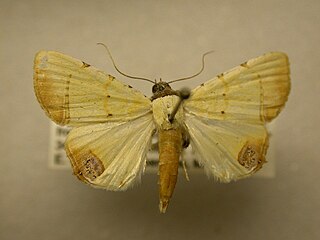Carmenta is a genus of moths in the family Sesiidae.
Tarache is a genus of moths of the family Noctuidae erected by Jacob Hübner. It includes most former New World Acontia species. Lepidoptera and Some Other Life Forms and The Global Lepidoptera Names Index report this name as a synonym of Acontia.
Dioptis is a genus of moths of the family Notodontidae. It consists of the following species:
Carmenta armasata is a moth of the family Sesiidae. It was described by Herbert Druce in 1892. It is known from the US state of Texas.
Carmenta laurelae is a moth of the family Sesiidae. It was described by Larry N. Brown, Thomas D. Eichlin and J. Wendell Snow in 1985, and is known from the US state of Florida.
Camaegeria sophax is a moth of the family Sesiidae first described by Herbert Druce in 1899. It is known from Malawi, Mozambique, Uganda and Zimbabwe.
Dioptis pallene is a moth of the family Notodontidae first described by Herbert Druce in 1893. It is found in Ecuador and Peru.
Eulepidotis hemithea is a moth of the family Erebidae first described by Herbert Druce in 1889. It is found in the Neotropics, including Panama and Guyana.

Eulepidotis micca is a moth of the family Erebidae first described by Herbert Druce in 1889. It is found in the Neotropics, including Panama, Costa Rica and Ecuador. It was recorded from Texas by Ed Knudson and Charles Bordelon in 2004.
Eulepidotis mustela is a moth of the family Erebidae first described by Herbert Druce in 1889. It is found in the Neotropics, including Mexico.
Apeplopoda mecrida is a moth of the family Erebidae. It was described by Herbert Druce in 1889. It found in the US state of Arizona, Mexico, Guatemala and Costa Rica.
Eois carmenta is a moth in the family Geometridae first described by Herbert Druce in 1892. It is found in Guatemala.
Cosmosoma ethodaea is a moth of the family Erebidae. It was described by Herbert Druce in 1889. It is found in Mexico.
Eucereon striata is a moth of the subfamily Arctiinae. It was described by Herbert Druce in 1889. It is found in Mexico, Costa Rica and Rio de Janeiro, Brazil.
Hypercompe amulaensis is a moth of the family Erebidae first described by Herbert Druce in 1889. It is found in Mexico.
Phoenicoprocta lydia, the Lydia tiger moth, is a moth in the subfamily Arctiinae. It was described by Herbert Druce in 1889. It is found in Mexico and southern Texas.
Ptychoglene phrada is a moth in the subfamily Arctiinae. It was described by Herbert Druce in 1889. It is found in Arizona and Mexico.
Virbia esula is a moth in the family Erebidae. It was described by Herbert Druce in 1889. It is found in Mexico.
Virbia feronia is a moth in the family Erebidae. It was described by Herbert Druce in 1889. It is found in Mexico.
Virbia semirosea is a moth in the family Erebidae first described by Herbert Druce in 1889. It is found in Mexico and on Hispaniola.
